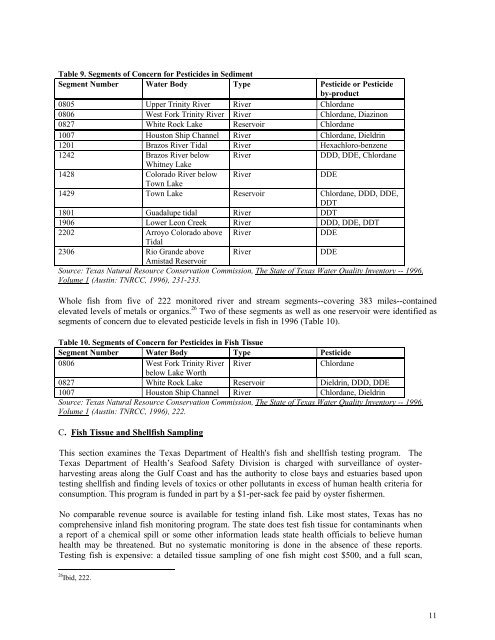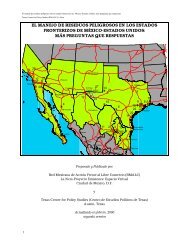Pesticides and Water Quality - Texas Center for Policy Studies
Pesticides and Water Quality - Texas Center for Policy Studies
Pesticides and Water Quality - Texas Center for Policy Studies
You also want an ePaper? Increase the reach of your titles
YUMPU automatically turns print PDFs into web optimized ePapers that Google loves.
Table 9. Segments of Concern <strong>for</strong> <strong>Pesticides</strong> in SedimentSegment Number <strong>Water</strong> Body Type Pesticide or Pesticideby-product0805 Upper Trinity River River Chlordane0806 West Fork Trinity River River Chlordane, Diazinon0827 White Rock Lake Reservoir Chlordane1007 Houston Ship Channel River Chlordane, Dieldrin1201 Brazos River Tidal River Hexachloro-benzene1242 Brazos River below RiverDDD, DDE, ChlordaneWhitney Lake1428 Colorado River below RiverDDETown Lake1429 Town Lake Reservoir Chlordane, DDD, DDE,DDT1801 Guadalupe tidal River DDT1906 Lower Leon Creek River DDD, DDE, DDT2202 Arroyo Colorado above RiverDDETidal2306 Rio Gr<strong>and</strong>e above RiverDDEAmistad ReservoirSource: <strong>Texas</strong> Natural Resource Conservation Commission, The State of <strong>Texas</strong> <strong>Water</strong> <strong>Quality</strong> Inventory -- 1996,Volume 1 (Austin: TNRCC, 1996), 231-233.Whole fish from five of 222 monitored river <strong>and</strong> stream segments--covering 383 miles--containedelevated levels of metals or organics. 26 Two of these segments as well as one reservoir were identified assegments of concern due to elevated pesticide levels in fish in 1996 (Table 10).Table 10. Segments of Concern <strong>for</strong> <strong>Pesticides</strong> in Fish TissueSegment Number <strong>Water</strong> Body Type Pesticide0806 West Fork Trinity River RiverChlordanebelow Lake Worth0827 White Rock Lake Reservoir Dieldrin, DDD, DDE1007 Houston Ship Channel River Chlordane, DieldrinSource: <strong>Texas</strong> Natural Resource Conservation Commission, The State of <strong>Texas</strong> <strong>Water</strong> <strong>Quality</strong> Inventory -- 1996,Volume 1 (Austin: TNRCC, 1996), 222.C. Fish Tissue <strong>and</strong> Shellfish SamplingThis section examines the <strong>Texas</strong> Department of Health's fish <strong>and</strong> shellfish testing program. The<strong>Texas</strong> Department of Health’s Seafood Safety Division is charged with surveillance of oysterharvestingareas along the Gulf Coast <strong>and</strong> has the authority to close bays <strong>and</strong> estuaries based upontesting shellfish <strong>and</strong> finding levels of toxics or other pollutants in excess of human health criteria <strong>for</strong>consumption. This program is funded in part by a $1-per-sack fee paid by oyster fishermen.No comparable revenue source is available <strong>for</strong> testing inl<strong>and</strong> fish. Like most states, <strong>Texas</strong> has nocomprehensive inl<strong>and</strong> fish monitoring program. The state does test fish tissue <strong>for</strong> contaminants whena report of a chemical spill or some other in<strong>for</strong>mation leads state health officials to believe humanhealth may be threatened. But no systematic monitoring is done in the absence of these reports.Testing fish is expensive: a detailed tissue sampling of one fish might cost $500, <strong>and</strong> a full scan,26 Ibid, 222.11




